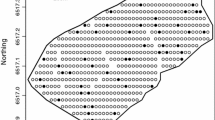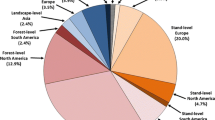Abstract
The Nelder (Biometrics 18:283–307, 1962) wheel design allows a researcher to test multiple tree densities in a single plot. Because spatial relationships among planted trees are fundamental to a Nelder wheel, a researcher needs a specific set of layout parameters to establish a Nelder plot. While Nelder (Biometrics 18:283–307, 1962) provides calculus-based equations for determining the required layout parameters, the presentation focuses on derivation of these equations and not their application to forestry research. Other authors have outlined the design of Nelder plots for forestry research, but have done so using trigonometry-based equations. Existence of two layout methodologies in the literature is a source of confusion. In this paper, we present a straightforward means to determine the design parameters critical to the establishment of Nelder plots used within tree density research. The layout equations presented are expressed in terms that allow applied forestry researchers to easily answer the following question. Given the number and range of tree densities I want to evaluate, what are the required Nelder wheel layout parameters? Finally, we provide a step-by-step example of the design and installation of a Nelder plot for a scenario familiar to tree density research and discuss analysis of Nelder wheel experiments.


Similar content being viewed by others
References
Affleck DLR (2001) A comparative study of spatial analysis methods for forestry Nelder experiments. M.S. Thesis, Department of Forest Resources Management, University of British Columbia, Vancouver, Canada
Aphalo PJ, Rikala R (2006) Spacing of silver birch seedlings grown in containers of equal size affects their morphology and its variability. Tree Physiol 26(9):1227–1237
Bleasdale JKA (1967) Systematic designs for spacing experiments. Method Exp Agric 3:73–85
Faber P (1991) A distance-dependent model of tree growth. For Ecol Manag 41(1–2):111–123
Fox JC, Ades PK, Bi H (2001) Stochastic structure and individual-tree growth models. For Ecol Manag 154(1–2):261–276
Geyer WA (2006) Biomass production in the Central Great Plains USA under various coppice regimes. Biomass Bioenergy 30(8–9):778–783
Hall RB (1994) Use of the crown competition factor concept to select clones and spacings for short-rotation woody crops. Tree Physiol 14(7–8-9):899–909
Imada M, Kunisaki T, Mizoue N, Teraoka Y (1997) Optimum planting density for Japanese oak (Quercus mongolica var.grosseserrata) based on spacing experiment with systematic design. J For Res 2(2):89–93
Knowe SA, Hibbs DE (1996) Stand structure and dynamics of young red alder as affected by planting density. For Ecol Manag 82(1–3):69–85
Krinard RM (1985) Cottonwood development through 19 years in a Nelder’s design. USDA For. Serv., Southern Forest Experiment Station, Asheville, NC, Res. Note, SO-322, p 4
Mabvurira D, Miina J (2002) Individual-tree growth and mortality models for Eucalyptus grandis (Hill) Maiden plantations in Zimbabwe. For Ecol Manag 161(1–3):231–245
Mark WB (1983) Spacing trials using the Nelder wheel. In: Standiford RB, Ledig FT (eds) Proceedings of a work-shop on Eucalyptus in California. USDA For. Serv., Pacific Southwest Forest and Range Experiment Station, Berkeley, CA, Gen. Tech. Rep., pp 81–86
Namkoong G (1966) Application of Nelder’s designs in tree improvement research. In: Southern Forest Tree Improvement Committee (ed) Proceedings of the eighth southern conference on forest tree improvement. School of Forestry, North Carolina State College, Raleigh, NC, pp 24–37
Nelder JA (1962) New kinds of systematic designs for spacing experiments. Biometrics 18(3):283–307
Pinheiro JC, Bates DM (2000) Mixed-effects models in S and S-PLUS. Statistics and computing. Springer, New York
Redmond J, Gallagher G, Mac Siúrtáin M (2005) Systematic spacing trials for plantation research and demonstration. Department of Agriculture, Fisheries and Food, Programme of Competitive Forestry Research for Development, Dublin, Ireland, COFORD Connects Silviculture/Management No. 12, p 6
Ritchie GA, Keeley J, Bond BJ (2007) The density effect: red/fer red signaling and Douglas-fir seedling growth in a variable density field test. In: Riley LE, Dumroese RK, Landis TD (eds) National proceedings: forest and conservation nursery associations—2006. USDA For. Serv., Rocky Mountain Research Station, Fort Collins, pp 38–45
Schlönvoigt A, Beer J (2001) Initial growth of pioneer timber tree species in a Taungya system in the humid lowlands of Costa Rica. Agrofor Syst 51(2):97–108
Stape JL, Binkley D (2010) Insights from full-rotation Nelder spacing trials with Eucalyptus in São Paulo, Brazil. South For 72(2):91–98
Waghorn MJ, Watt MS, Mason EG (2007) Influence of tree morphology, genetics, and initial stand density on outerwood modulus of elasticity of 17-year-old Pinus radiata. For Ecol Manag 244(1–3):86–92
West PW (2006) Growing plantation forests. Springer, New York
West B, Welch KB, Galecki AT (2007) Linear mixed models: a practical guide using statistical software. Chapman & Hall/CRC, Boca Raton
Author information
Authors and Affiliations
Corresponding author
Rights and permissions
About this article
Cite this article
Parrott, D.L., Brinks, J.S. & Lhotka, J.M. Designing Nelder wheel plots for tree density experiments. New Forests 43, 245–254 (2012). https://doi.org/10.1007/s11056-011-9278-4
Received:
Accepted:
Published:
Issue Date:
DOI: https://doi.org/10.1007/s11056-011-9278-4




